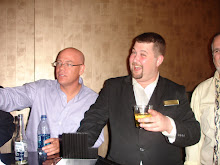It was the summer of '07 and I had just finished the design plans for the permanent gaming facility when I caught the inbound email outlining an upcoming meeting to discuss the merging of all our “projects”. Having successfully opened several restaurants and one casino I was very familiar with time line's, dependency charts, and Gantt's. I knew what I needed to do to make the door swing open, however a project of this size required more. I needed to know who was responsible for certain items and when they would be completed. With something this big it's not just the one guy that keeps track of all the tasks associated with opening. There was a person responsible for every group of tasks and we were each interdependent on certain items completion before certain other tasks could begin. Steve, the AGM sort of spearheaded the meeting. He's opened dozens of property's all over the world, he's a real calm collected kind of dude that just seems to know everybody. The meeting helped us identify the critical path, the items that directly affected the opening date. It also guided us through the project's process in a few key ways.
The first thing Steve asked us to do was to decide on our individual tasks. We individually brainstormed for a few weeks and compiled a list of tasks. This was a daunting task at times. You think about the big picture, the Casino opens. Then you start listing off the larger tasks that have to happen before the big picture, IE the restaurant is ready to open, the lounge is ready to open, the offices are ready, etc... Then you get into the good stuff, the real meat of a project. You drill down on each of these items, flooring is complete in the restaurant, the staff is hired, trained, clothed, and scheduled, the furniture, fixtures, and equipment have been identified, ordered, delivered, and installed, the food has been identified, ordered, prepared, tested, tested again, and re-ordered. What starts as one goal, or an “end” if you can picture it becomes a list of thousands of tasks.
Then came the post-its. Each task is elaborated on in a few ways: who is responsible for the completion of the task, what are the short details of the task, when must the task start, how long will it take, and when must it end. Steve had us take our lists and hand write each of the pieces of information on a yellow post-it. We then littered our individual office walls with this venerable flurry of notes and began to sort logically. We developed individual trees of sorts where the tasks started in chronological order, from beginning to end, but they had to be trailed by their dependencies. This took weeks to complete, each of us trying to put together a building but with missing pieces. The object of the exercise was to identify the gaps created by others tasks and to become intimate with our own. Then each of us took the notes in the order and arrangement that made the most sense to us and captured them in our respective project time lines.
Lastly, we met with intentions of merging all of our post-its in an effort to come up with a comprehensive project time line. Each of us arrived to the meeting with all of our post-it's in an ordered stack. We then individually presented our tasks to the executive committee and talked through where we saw their places in the time line. The discussion was as a group, we all help guide each others tasks into the mass, the matrix that was evolving a little more as each presenter finished. This helped us bind our tasks together and fill in all the gaps. We completed the exercise and ended it with a 25' by 20' boardroom wallpapered with post-its. From here all of the data was collected and entered as one large project with several milestones based on departmental achievements. The post-its were torn down and the new plotter printed time lines then covered the walls.
We now had a formal plan of attack, an approach, a guide, and a way to know when we had finished. This process as unusual as it seemed to me at the time, was probably the most effective way I've ever seen a large scale project organized. I believe that it was this plan and our strict adherence to it that made this opening happen the way it did. Our property's opening was acclaimed as the smoothest and most successful property open in the companies short history. Several of us caught a lot of positive industry attention as the word spread of our success. I was happy to be a part of this process and the opening, but I'm happier still that I can say to a degree that “I did that”.
Wednesday, March 25, 2009
Subscribe to:
Post Comments (Atom)

Strongest in the first two grafs where you're most specific, weaker when the material could apply to any big project. But it works for logic, structure, balance. Glad to take it.
ReplyDelete